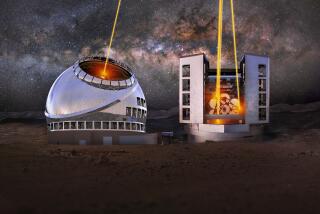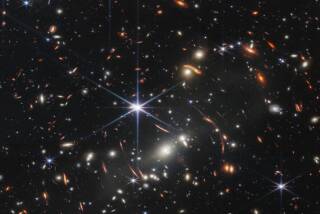100 Targets Within 30 Light-Years of Earth : New Telescope May Spot Planets of Other Stars
Astronomers are developing a telescope they believe will be so precise that it will enable them to see planets around other stars for the first time.
To be successful, they will have to produce a mirror nearly five feet in diameter and free of even microscopic ripples, a level of perfection that has never been achieved before, according to Richard J. Terrile of the Jet Propulsion Laboratory, who is behind the effort.
Terrile, a planetary astronomer, said the mirror will have to be 15 times smoother than the mirror in the Hubble Space Telescope, the crown jewel of the astronomical community that is now scheduled to be launched into orbit around the Earth in 1989.
The circumstellar imaging telescope that Terrile and his associates are developing would also have to be placed in orbit where it would be free of the distortion caused by the Earthâs atmosphere. Although construction of the telescope has not yet been funded, Terrile said that the National Aeronautics and Space Administration has encouraged the effort and that he hopes to see it in orbit by the mid-1990s.
$200,000 Spent So Far
So far, he estimates, about $200,000 has been spent on the project from discretionary research funds available to JPL Director Lew Allen. He said it is too early to know what the actual telescope would cost, but he offered a preliminary estimate of $100 million. The Space Telescope, which is a complex, multipurpose instrument, cost well above $1 billion.
Terrile believes that the telescope he is now developing could produce photographs of any planets as large as Jupiter orbiting another star. The most promising candidates include about 100 stars within 30 light-years of Earth. Those stars are similar to the only star in the universe known to have planets--our own sun--and they are close enough to Earth for the telescope to be effective.
The next step, Terrile said, is to prove that the telescope is feasible.
âWeâre exploring new ground,â he said Wednesday in an interview during the annual meeting of the planetary sciences division of the American Astronomical Society in Pasadena.
Although the specific purpose of the telescope would be to find other planetary systems, in principle it could be used to study any dim object near a very bright star, he said. That would satisfy a need that no instrument in the world can meet now, overcoming an obstacle that until recently many scientists felt could never be conquered.
If there are other planets near another star, they cannot be seen with any telescope available today because the light from the star is so much brighter than the light reflected by the planets. And even the best telescopes suffer from something called âlight scattering,â which occurs whenever light encounters an imperfection--such as a tiny ripple in the surface of the mirror--that causes some of the light to scatter across the image.
âDown to Atomic Levelâ
The fewer imperfections, the less the scattering, but if the target is a dim planet beside a star a billion times brighter, almost any scattering would mean defeat.
Terrile said an area in the mirror the size of a human hand could not tolerate a single imperfection, such as a wave in the surface, even if the flaw was so shallow that it would be microscopic in depth.
The level of perfection required in the mirror âis almost down to the atomic level,â he said.
It turns out, he added, that mirrors approaching that quality are already in production. They are used in the electronics industry as optics in the reproduction of printed microcircuits. They are about a third the size of the one needed for the telescope.
âThese mirrors are mass-produced at the rate of 20 per month, and they are five times the smoothness of Space Telescope,â he said. âWe want them to be at least twice that good, and the real question is, can they do that? Weâre putting it to the test.â
âResults ... Encouragingâ
Terrile turned to Perkin-Elmer Corp., the Connecticut firm that built the Space Telescope. Christ Ftacias and Edward T. Siebert of Perkin-Elmer are working with Terrile to see if they can make a 10-inch mirror that meets the standards required for the telescope.
âWe had some preliminary results a few days ago,â Terrile said. âThey were encouraging.â
Terrile said he does not know the technique used by the company to grind the mirrors.
âThese are almost black magic secrets,â he said, referring to the level of security demanded by companies engaged in what has become a highly competitive business.
The proposal for the telescope was formally presented to NASA last December, and it has quickly won support within the agency, he said. The timing coincides with high-level interest at NASA in the search for other planetary systems that could support intelligent beings.
More to Read
Sign up for Essential California
The most important California stories and recommendations in your inbox every morning.
You may occasionally receive promotional content from the Los Angeles Times.










